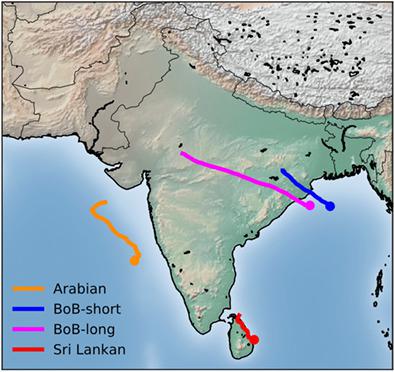Weather ( IF 2.3 ) Pub Date : 2021-05-30 , DOI: 10.1002/wea.3997 Akshay Deoras 1 , Kieran M. R. Hunt 1, 2 , Andrew G. Turner 1, 2

|
Introduction
The Indian subcontinent is affected by synoptic-scale cyclonic vortices each summer monsoon season (June–September). These vortices, known as monsoon low-pressure systems (LPSs), most frequently develop over the head of the Bay of Bengal (BoB) and adjoining land area, propagate west-northwestward over India, and produce abundant precipitation along their tracks (e.g. Mooley, 1973; Godbole, 1977). LPSs have triggered several catastrophic floods in the Indian subcontinent, including the 2018 Kerala floods (Hunt and Menon, 2020). Previous studies have suggested that LPSs, which have an average lifespan of 3 to 5 days, are responsible for around half of the summer monsoon rainfall over India (e.g. Yoon and Chen, 2005; Hunt and Fletcher, 2019).
According to the India Meteorological Department,1
1
http://imdnagpur.gov.in/docs_general/monsoonfaq.pdf
systems featuring two closed isobars in surface pressure at 2 hPa intervals over land, or those featuring 3-minute maximum sustained surface wind speeds of 8.5–13.5 m s−1 over sea are referred to as monsoon depressions, whereas systems weaker than this are referred to as monsoon low-pressure areas. Typically, around 14 LPSs form each summer and half of them intensify into monsoon depressions (Boos et al., 2015). Both the frequency and lifespan of LPSs are larger in July and August than in June and September (Krishnamurthy and Ajayamohan, 2010).
Of particular importance to this study are the structures of thermodynamic and moisture fields of LPSs (Godbole, 1977; Hunt et al., 2016) and the relationship between intraseasonal modes of rainfall and LPS frequency (Krishnamurthy and Ajayamohan, 2010). LPSs have a warm-over-cold core structure; the lower-tropospheric cold core is a result of evaporative cooling of precipitation and reduced insolation due to significant cloud cover (Sarker and Choudhary, 1988; Sørland and Sorteberg, 2015), whereas latent heating from deep convection is responsible for the warm core (Keshavamurty et al., 1978). The LPS frequency during the active phase of the monsoon is nearly 3.5 times higher than during the break phase, and nearly 7 times higher for monsoon depressions (Goswami et al., 2003; Krishnamurthy and Shukla, 2007). Krishnamurthy and Ajayamohan (2010) analysed LPSs during all phases of the two intraseasonal modes, which were first obtained by Krishnamurthy and Shukla (2007, 2008). These intraseasonal modes are related to the Boreal Summer Intraseasonal Oscillation (BSISO), to be discussed later in this section. They concluded that the location and area covered by LPSs are tied to the propagation of convective anomalies of these intraseasonal modes — LPS tracks occur further south over the subcontinent when convective anomalies are located over the equatorial Indian Ocean, and further north when the convective anomalies are located over India and the northwestern Pacific Ocean.
Haertel and Boos (2017) found that LPS frequency is not significantly affected by the amplitude of the Madden-Julian Oscillation (MJO). With increasing MJO amplitude, there is a slight decrease in the number of monsoon low-pressure areas, but roughly the same number of monsoon depressions and deep depressions. However, LPS frequency is modulated by MJO phase, with phases 4–6 (where convection is favoured over the eastern Indian Ocean and the western Pacific Ocean) supporting the genesis of LPSs in general. While the eastward-propagating MJO is the most prominent mode of the tropical intraseasonal oscillation (ISO) in boreal winter, the BSISO prevails in boreal summer (Wang and Xie, 1997; Kikuchi et al., 2012). The convective anomalies associated with the BSISO show an additional northward/northeastward propagation over the Indian summer monsoon region (e.g. Yasunari, 1979) and northward/northwestward propagation over the Western North Pacific and East Asian regions (e.g. Murakami, 1984). Suhas et al. (2013) proposed the Monsoon Intraseasonal Oscillation (MISO) index as another index for monitoring the northward-propagating component of the ISO over the Indian summer monsoon region. Unlike for the MJO, formal relationships between LPS frequency and the northward-propagating component of the ISO, as measured by the BSISO and MISO indices, have not been explored in the past.
- What are the differences between track statistics for the four LPS varieties?
- Are there important structural or thermodynamical differences between the different LPS varieties?
- How much precipitation is contributed by each LPS variety to the seasonal mean precipitation?
- How does the ISO, as measured by the BSISO, MISO and MJO indices, modulate LPS activity of each variety?
中文翻译:

南亚季风低压系统的四种区域变化及其对热带季节内变率的调制
介绍
印度次大陆在每个夏季季风季节(6 月至 9 月)都会受到天气尺度气旋涡旋的影响。这些被称为季风低压系统 (LPS) 的涡旋最常在孟加拉湾 (BoB) 和毗邻的陆地区域上空形成,在印度向西北偏西方向传播,并沿其轨迹产生大量降水(例如 Mooley , 1973 年;戈德博尔, 1977 年)。LPS 在印度次大陆引发了几次灾难性洪水,包括 2018 年喀拉拉邦洪水(Hunt 和 Menon, 2020 年)。以前的研究表明,平均寿命为 3 到 5 天的 LPS 是造成印度夏季季风降雨量的一半左右的原因(例如 Yoon 和 Chen, 2005 年;Hunt 和 Fletcher, 2019 年)。
据印度气象部门称,1
1
http://imdnagpur.gov.in/docs_general/monsoonfaq.pdf
在陆地上以2 hPa间隔具有两个闭合等压线的表面压力系统,或在海上具有3分钟最大持续地表风速为8.5-13.5 m s -1的系统被称为季风低压,而比这弱的系统被称为作为季风低压区。通常,每年夏天会形成大约 14 个 LPS,其中一半会加剧为季风洼地(Boos等, 2015)。LPS 的频率和寿命在 7 月和 8 月都大于 6 月和 9 月(Krishnamurthy 和 Ajayamohan, 2010 年)。
本研究特别重要的是LPS的热力学和水分场结构(Godbole, 1977;Hunt等,2016)以及降雨的季节内模式与LPS频率之间的关系(Krishnamurthy和Ajayamohan, 2010)。LPS 具有暖过冷核心结构;对流层低层冷核是降水蒸发冷却和大量云层覆盖导致日照减少的结果(Sarker 和 Choudhary, 1988 年;Sørland 和 Sorteberg, 2015 年),而深层对流的潜热加热是造成暖核的原因(Keshavamurty等, 1978)。季风活跃期的 LPS 频率比中断期高出近 3.5 倍,季风洼地高出近 7 倍(Goswami等, 2003;Krishnamurthy 和 Shukla, 2007)。Krishnamurthy 和 Ajayamohan ( 2010 ) 分析了两种季节内模式的所有阶段的 LPS,这是 Krishnamurthy 和 Shukla ( 2007 年,2008 年)首先获得的)。这些季节内模式与北方夏季季节内振荡 (BSISO) 相关,将在本节后面讨论。他们得出的结论是,LPS 覆盖的位置和区域与这些季节内模式的对流异常的传播有关——当对流异常位于赤道印度洋上空时,LPS 轨迹发生在次大陆的更南部,当对流异常位于更北时位于印度和西北太平洋上空。
Haertel 和 Boos ( 2017 ) 发现 LPS 频率不受 Madden-Julian 振荡 (MJO) 振幅的显着影响。随着 MJO 振幅的增加,季风低压区的数量略有减少,但季风洼地和深洼地的数量大致相同。然而,LPS 频率受 MJO 相位调制,相位 4-6(在东印度洋和西太平洋有利于对流)总体上支持 LPS 的起源。东向传播的 MJO 是北半球冬季最突出的热带季内振荡(ISO)模式,而北半球夏季则以 BSISO 为主(Wang 和 Xie, 1997;Kikuchi等,2012))。与 BSISO 相关的对流异常表明,印度夏季风地区(如 Yasunari,1979 年)和北太平洋西部和东亚地区(如 Murakami,1984 年)有额外的向北/东北向传播 和向北/西北向传播 。苏哈斯等人。( 2013 ) 提出了季风季内振荡 (MISO) 指数作为另一个监测印度夏季风区 ISO 向北传播分量的指数。与 MJO 不同,LPS 频率与 ISO 向北传播分量(由 BSISO 和 MISO 指数衡量)之间的正式关系在过去没有被探索过。
- 四种 LPS 品种的赛道统计数据有何不同?
- 不同 LPS 品种之间是否存在重要的结构或热力学差异?
- 每个 LPS 品种对季节性平均降水贡献了多少?
- ISO(由 BSISO、MISO 和 MJO 指数衡量)如何调节每个品种的 LPS 活性?











































 京公网安备 11010802027423号
京公网安备 11010802027423号